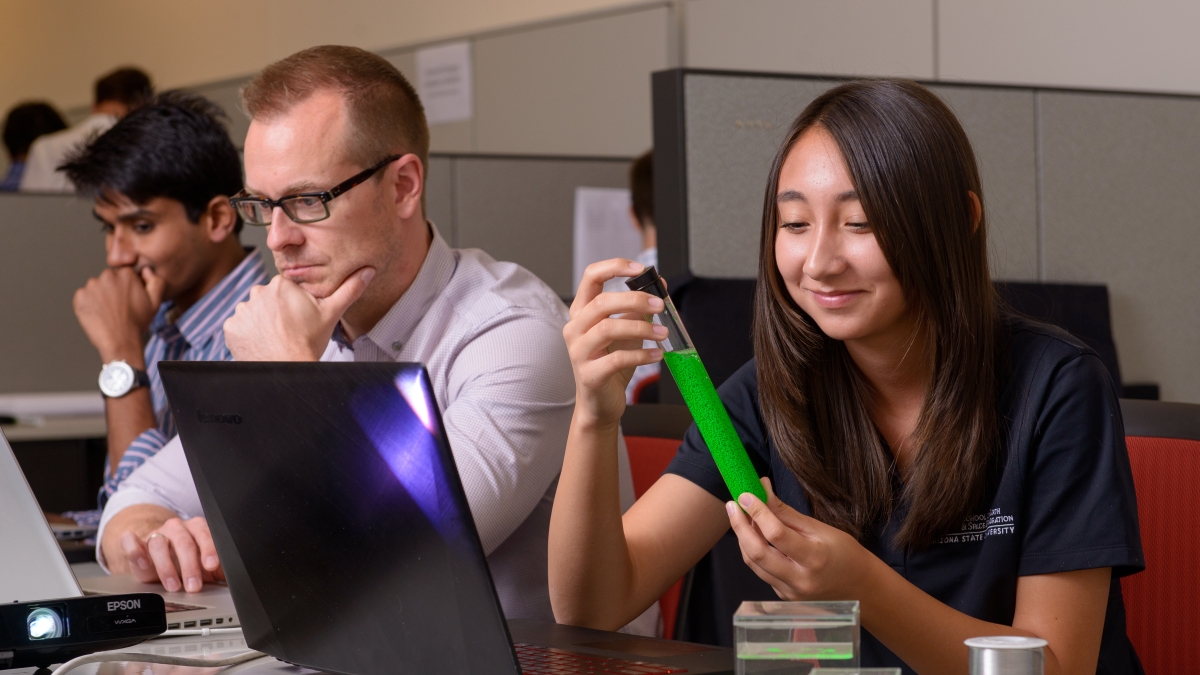ASU earth and space exploration degree prepares students with interdisciplinary collaboration

Students in the Space and Terrestrial Robotic Exploration Laboratory help develop systems engineering design and control solutions for space, planetary and asteroid exploration. Photo by Andy DeLisle
The undergraduate degree in earth and space exploration at Arizona State University combines science, engineering and education to investigate Earth, its solar system and the universe.
“We’re working aggressively to get research experiences into the classroom so even more students can have a knowledge creation experience,” said Lindy Elkins-Tanton, professor and director of the School of Earth and Space Exploration in the College of Liberal Arts and Sciences. “That’s the big thrill and the big motivator, to create something that has not existed before.”
The Bachelor of Science program offers undergraduates an integrated education, which focuses on earth sciences, planetary sciences, astrophysics and engineering. Students can diversify their knowledge by studying a range of interdisciplinary fields or can hone their expertise on a single discipline.
“The School of Earth and Space Exploration is innovative and unique because it's an interdisciplinary department that actually works,” said Christopher Groppi, associate professor of astronomy and astrophysics. “From the first semester, our undergraduate majors experience their assignments all the way to major NASA-funded space missions.”
The value of an earth and space exploration degree
Undergraduate students pursuing a degree in earth and space exploration are highly involved. From building deep-space instruments for NASA missions to discovering more about Earth’s natural environment and resources, the school prepares students for a new era of exploration with hands-on experience.
“The School of Earth and Space Exploration provides a remarkable opportunity for students to participate on projects where researchers are building and operating instruments going to Mars, Europa and a suite of asteroids,” Regents’ Professor Philip Christensen said.
In addition to traditional classroom lectures, students have the opportunity to cross subject boundaries and conduct research in the field and in state-of-the-art labs with experts in astronomy, astrophysics, cosmology, geosciences, planetary sciences, exploration systems engineering and science education.
“I think the school’s devotion to interdisciplinary collaboration is crucial. It’s extremely valuable,” ASU alumnus Jim Crowell said. “I came to ASU interested in astronomy, then I had a taste of planetary geology, and then I was able to try my hand at developing technology. Where else can you find a place that encourages such interdisciplinary work and also does it so well?”
Post-graduation opportunities
Graduates of the earth and space exploration program have pursued graduate and doctoral programs all over the country.
For example, Crowell received a Master of Science in geological sciences and won the gold at the Southwest Regionals of FameLab, an international competition for new science and engineering communications. He worked as a robotics engineer for the NASA Jet Propulsion Laboratory and currently is a research engineer at the Extreme Environments Robotics and Instrumentation Laboratory.
Angie Bond-Simson, a senior hydrologist at Salt River Project, earned her master’s degree in geological sciences from the university in 2010. She attributes her career success to faculty who challenged her academically and encouraged her to take on field internships during her studies.
In spring 2013, alumna Pye Pye Khin Zaw received her undergraduate degree. She went on to pursue a master’s degree in engineering management through the Ira A. Fulton Schools of Engineering. Currently, she works in systems engineering at Bigelow Aerospace, where she started the Bigelow Expandable Activity Module program.
“For me it was truly a life-changer to be in a program that completely aligned with my fascination regarding earth and space,” Zaw said. “The fusion between science and engineering, I believe, made me a better engineer.”
More Science and technology

SpaceHACK highlights student solutions to environmental challenges, digital divide
By Adrianna Nine About 250 students from around the world convened online and at Arizona State University on March 22 for the…

New AI for a new era of discovery
As the legend goes, in 1665, Sir Isaac Newton sat in his garden at Woolsthorpe Manor in England and looked on as a lone apple…

ASU receives 3 awards for research critical to national security
Three researchers in the Ira A. Fulton Schools of Engineering at Arizona State University have received grant awards under the …